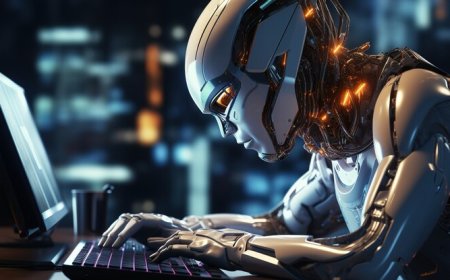Introduction to Machine Learning with Python
Learn the basics of machine learning with Python. Discover essential concepts and practical applications in this introductory guide.

From autonomous vehicles to personalized recommendations, machine learning algorithms are at the heart of these advancements. Python, a versatile and popular programming language, provides an ideal platform for implementing and exploring the vast landscape of machine learning. In this blog, we will embark on a journey to demystify machine learning concepts and demonstrate how Python can be used to build powerful predictive models.
Understanding Machine Learning
Machine learning is a subset of artificial intelligence that enables computers to learn from data and make predictions or take actions without being explicitly programmed. It involves the development of algorithms that automatically learn patterns and relationships within the data, allowing them to make accurate predictions or decisions on new, unseen instances.
There are three main types of machine learning: supervised learning, unsupervised learning, and reinforcement learning.
Supervised learning involves training a model on a labeled dataset, where each data instance is associated with a known target variable. The model learns to map input features to their corresponding outputs. This type of learning is commonly used for tasks such as classification and regression.
Unsupervised learning, on the other hand, deals with unlabeled data. The goal is to discover hidden patterns or structures within the data. Clustering is a popular technique in unsupervised learning, where the algorithm groups similar instances together based on their characteristics. Dimensionality reduction is another technique used to reduce the number of variables in the data while preserving important information.
Reinforcement learning focuses on training agents to interact with an environment and learn from the feedback they receive in the form of rewards or punishments. The goal is to find the optimal policy that maximizes the cumulative reward. Reinforcement learning has applications in areas such as robotics, game playing, and autonomous systems.
Python has emerged as a popular programming language for machine learning due to its simplicity, readability, and a wide range of libraries and frameworks. Libraries such as NumPy, pandas, scikit-learn, TensorFlow, and PyTorch provide powerful tools and functionalities for handling data, implementing machine learning algorithms, and building complex models.
By leveraging the capabilities of Python and its machine learning libraries, it is possible to build predictive models, analyze data, and gain insights from vast amounts of information. Python's user-friendly syntax and extensive documentation make it accessible to both beginners and experienced practitioners.
Types of Machine Learning
1. Supervised Learning: This type of learning involves training a model on a labeled dataset, where each data instance is associated with a known target variable. The model learns to map input features to their corresponding outputs. Common supervised learning algorithms include linear regression, decision trees, support vector machines, and neural networks.
2. Unsupervised Learning: In unsupervised learning, the algorithm deals with unlabeled data, seeking to discover hidden patterns or structures within it. Clustering and dimensionality reduction are the two main techniques used in unsupervised learning. K-means clustering, hierarchical clustering, and principal component analysis (PCA) are popular algorithms in this category.
3. Reinforcement Learning: Reinforcement learning is concerned with training agents to interact with an environment and learn from the feedback received in the form of rewards or punishments. The goal is to find the optimal policy that maximizes the cumulative reward. Reinforcement learning has applications in robotics, game playing, and autonomous systems.
Python for Machine Learning
Python has become one of the most popular programming languages for machine learning due to its simplicity, versatility, and a rich ecosystem of libraries and frameworks specifically designed for data science and machine learning tasks. Let's delve into some of the key reasons why Python is widely used for machine learning:
1. Readability and Simplicity: Python's clean and readable syntax makes it easy to write and understand code, which is particularly advantageous when working on complex machine learning projects. The code is often more concise and expressive compared to other languages, allowing for faster development and easier collaboration among team members.
2. Vast Ecosystem of Libraries: Python offers an extensive collection of libraries and frameworks that provide powerful tools and functionalities for various stages of the machine learning pipeline. Some of the essential libraries include:
- NumPy: NumPy provides efficient and versatile numerical computing capabilities, including multi-dimensional array operations, linear algebra, and mathematical functions. It serves as a fundamental library for handling data in machine learning tasks.
- pandas: pandas is a versatile data manipulation library that offers high-performance data structures and data analysis tools. It simplifies tasks such as data cleaning, preprocessing, merging, and transformation, making it indispensable for data scientists.
- scikit-learn: scikit-learn is a comprehensive and user-friendly machine learning library that provides a wide range of algorithms and tools for tasks such as data preprocessing, model training, model selection, and evaluation. It also includes utilities for feature extraction, dimensionality reduction, and model persistence.
- TensorFlow and PyTorch: These are powerful deep learning libraries widely used for building and training neural networks. They provide high-level APIs, as well as lower-level functionalities for more advanced customization. Both libraries offer GPU acceleration for faster computations.
3. Community Support and Documentation: Python has a vibrant and active community of data scientists, machine learning practitioners, and developers. This community provides extensive documentation, tutorials, and online forums where users can seek help, share insights, and collaborate on projects. The availability of resources and community support greatly accelerates learning and problem-solving.
4. Integration with Other Technologies: Python seamlessly integrates with other technologies and frameworks commonly used in the data science and machine learning ecosystem. For example, Python can be used in conjunction with Apache Spark for distributed computing, SQL databases for data retrieval and storage, and web frameworks such as Django or Flask for building machine learning-powered web applications.
5. Versatility and Interoperability: Python's versatility allows for easy integration of machine learning models into existing software systems. It supports interoperability with other languages like C/C++, Java, and R, enabling the utilization of existing libraries and systems developed in those languages. This interoperability facilitates the deployment of machine learning models in production environments.
Building a Simple Machine Learning Model in Python
To demonstrate the power of Python for machine learning, let's walk through the process of building a simple supervised learning model using the scikit-learn library.
First, we need to import the necessary libraries and load our dataset. Libraries like pandas and scikit-learn are commonly used for data handling and model training in Python.
Next, we split the dataset into features (input variables) and the target variable (the variable we want to predict). This step helps us separate the data that the model will learn from and the data we want to predict.
After splitting the data, we further divide it into training and testing sets. The training set is used to train the model, while the testing set is used to evaluate its performance on unseen data.
Once the data is prepared, we can choose a suitable algorithm for our task. In this case, let's use the decision tree classifier from scikit-learn. This algorithm is effective for classification tasks and works by building a tree-like model of decisions based on the input features.
We then train the model using the training data. The model learns to identify patterns and relationships within the features and their corresponding target values.
With the trained model, we can make predictions on the testing set. The model applies the learned patterns to unseen instances and predicts their corresponding target values.
To evaluate the model's performance, we compare the predicted values with the actual target values from the testing set. Common evaluation metrics include accuracy, precision, recall, and F1-score, among others.
By following these steps and leveraging the power of Python and its machine learning libraries, we can quickly build and evaluate simple predictive models. As we delve deeper into the field of machine learning, we can explore more advanced algorithms, fine-tune model parameters, and handle larger and more complex datasets.
Python's simplicity, extensive documentation, and vibrant community make it an excellent choice for beginners and experienced practitioners alike to dive into the fascinating world of machine learning and unlock its potential for solving real-world problems.
Python, with its simplicity and a vast array of machine learning libraries, has become the go-to language for data scientists and machine learning enthusiasts. In this blog, we explored the fundamentals of machine learning and demonstrated how Python can be used to build a simple predictive model using scikit-learn. This is just the tip of the iceberg in the world of machine learning, and there are endless possibilities to explore and innovate. So, dive into the fascinating world of machine learning with Python and unleash the power of data-driven algorithms.




































